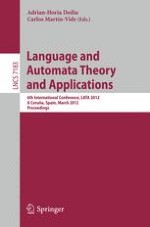This book constitutes the refereed proceedings of the 6th International Conference on Language and Automata Theory and Applications, LATA 2012, held in A Coruña, Spain in March 2012. The 41 revised full papers presented together with 3 invited talks and 2 invited tutorials were carefully reviewed and selected from 114 initial submissions. The volume features contributions from both classical theory fields and application areas; e.g. innformatics, systems biology, language technology, artificial intelligence, etc. Among the topics covered are algebraic language theory, automata and logic, systems analysis, systems verifications, computational complexity, decidability, unification, graph transformations, language-based cryptography, and applications in data mining, computational learning, and pattern recognition.
